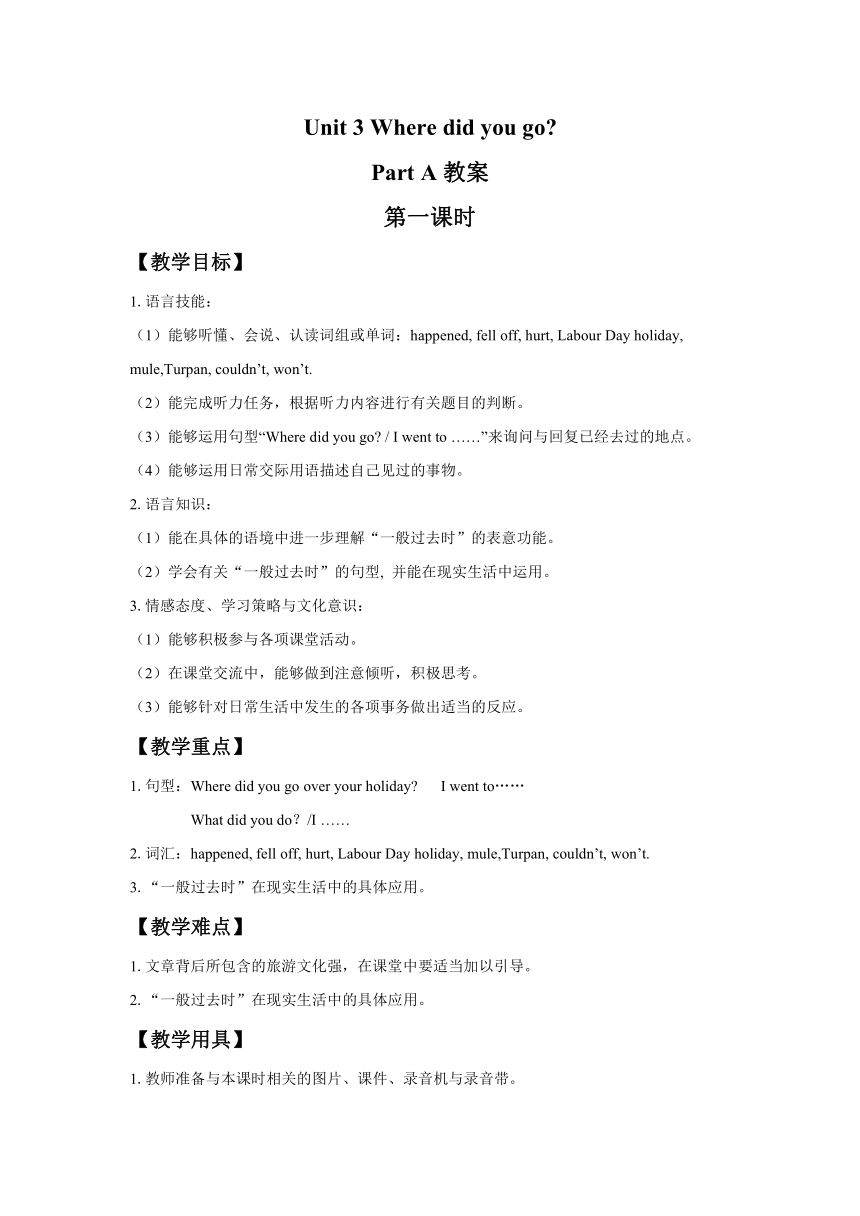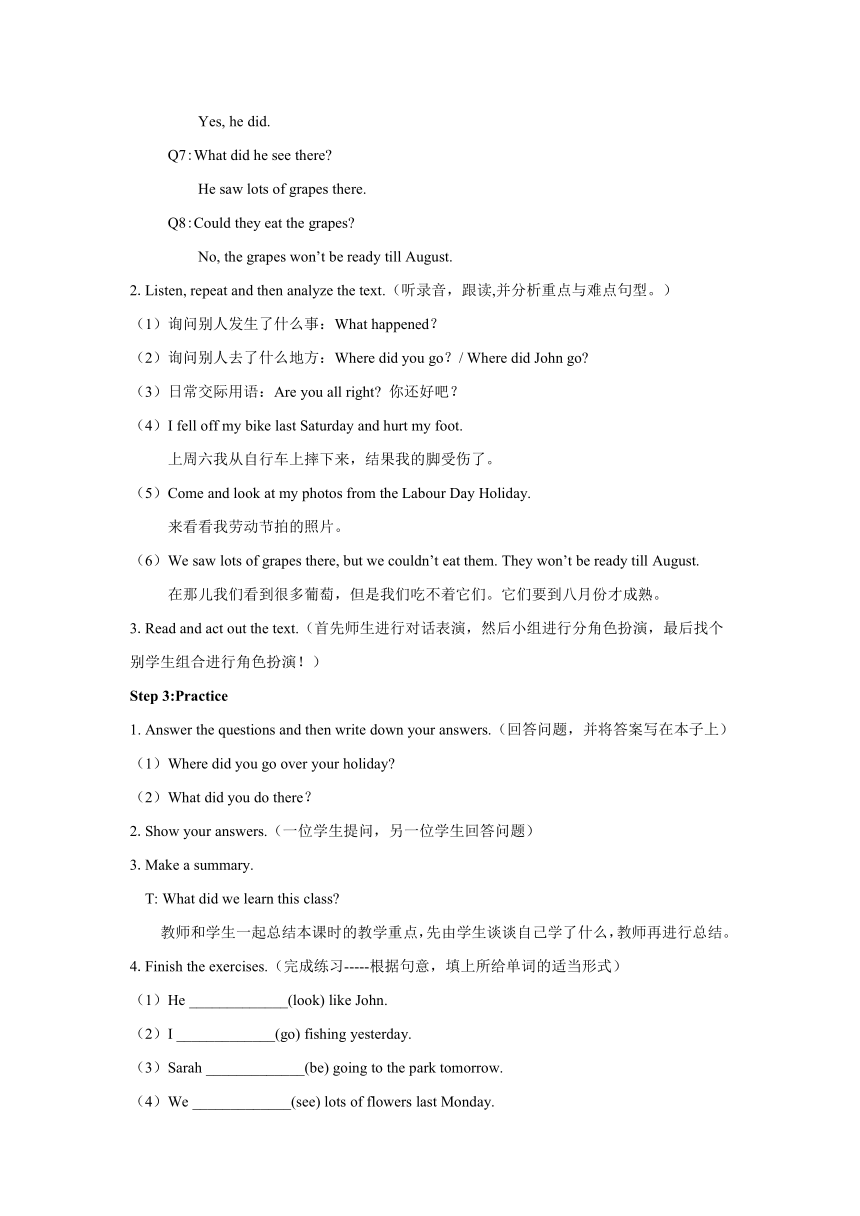人教版(PEP) 六年级下册Unit3 Where did you go Part A 教案(共2课时)
文档属性
| 名称 | 人教版(PEP) 六年级下册Unit3 Where did you go Part A 教案(共2课时) |  | |
| 格式 | zip | ||
| 文件大小 | 16.5KB | ||
| 资源类型 | 教案 | ||
| 版本资源 | 人教版(PEP) | ||
| 科目 | 英语 | ||
| 更新时间 | 2016-06-30 06:55:24 | ||
图片预览



文档简介
Unit
3
Where
did
you
go
Part
A教案
第一课时
【教学目标】
1.语言技能:
(1)能够听懂、会说、认读词组或单词:happened,
fell
off,
hurt,
Labour
Day
holiday,
mule,Turpan,
couldn’t,
won’t.
(2)能完成听力任务,根据听力内容进行有关题目的判断。
(3)能够运用句型“Where
did
you
go
/
I
went
to
……”来询问与回复已经去过的地点。
(4)能够运用日常交际用语描述自己见过的事物。
2.语言知识:
(1)能在具体的语境中进一步理解“一般过去时”的表意功能。
(2)学会有关“一般过去时”的句型,
并能在现实生活中运用。
3.情感态度、学习策略与文化意识:
(1)能够积极参与各项课堂活动。
(2)在课堂交流中,能够做到注意倾听,积极思考。
(3)能够针对日常生活中发生的各项事务做出适当的反应。
【教学重点】
1.句型:Where
did
you
go
over
your
holiday
I
went
to……
What
did
you
do?/I
……
2.词汇:happened,
fell
off,
hurt,
Labour
Day
holiday,
mule,Turpan,
couldn’t,
won’t.
3.“一般过去时”在现实生活中的具体应用。
【教学难点】
1.文章背后所包含的旅游文化强,在课堂中要适当加以引导。
2.“一般过去时”在现实生活中的具体应用。
【教学用具】
1.教师准备与本课时相关的图片、课件、录音机与录音带。
【教学过程】
Step
1:warm-up
1.Greeting.师生用英语互相问候。
2.Enjoy
the
pictures.(欣赏新疆景物,教师出示图片或者课件,引导学生了解新疆,引出课文部分重点与难点词汇Turpan,
Mt.
Tianshan,
Xinjiang,
mule,
ride
a
horse,
lots
of
grapes)
【设计意图】学生在欣赏景物的过程中,一边了解新疆,一边学习词汇,为学习课文打下坚实的铺垫。
3.Let’s
try.
教师引导学生完成Let’s
try
部分的练习。
学生先看课文中的文字提示语与两道题目,再判断三个句子的内容是否正确,学生带着问题听录音,抓住关键信息,正确判断题目。
Step
2:Presentation
1.Lead-in
(1)Talk
about
“Let’s
try”.(谈论Let’s
try部分的内容,引出John在劳动节去了新疆,进而引出Amy打电话联系John.)
T:We
know
Amy
phoned
John.
John
is
at
home.
He
didn’t
go
to
school.
Why
What
happened
【设计意图】循序渐进地学习课文,学生易于接受,自然而不突兀。
(2)Read
the
text
and
answer
the
questions.
Q1:What
happened
to
John
He
fell
off
his
bike
last
Saturday
and
hurt
his
foot.
Q2:Is
John
all
right
now
Yes,
he
is.
Q3:Where
did
John
go
Mt.
Tianshan,
Xinjiang.
Q4:What
did
he
do
He
rode
a
horse.
Q5:What’s
the
horse
like
It’s
very
small.
It
looks
like
a
mule.
Q6:Did
John
go
to
Turpan
Yes,
he
did.
Q7:What
did
he
see
there
He
saw
lots
of
grapes
there.
Q8:Could
they
eat
the
grapes
No,
the
grapes
won’t
be
ready
till
August.
2.Listen,
repeat
and
then
analyze
the
text.(听录音,跟读,并分析重点与难点句型。)
(1)询问别人发生了什么事:What
happened?
(2)询问别人去了什么地方:Where
did
you
go?/
Where
did
John
go
(3)日常交际用语:Are
you
all
right
你还好吧?
(4)I
fell
off
my
bike
last
Saturday
and
hurt
my
foot.
上周六我从自行车上摔下来,结果我的脚受伤了。
(5)Come
and
look
at
my
photos
from
the
Labour
Day
Holiday.
来看看我劳动节拍的照片。
(6)We
saw
lots
of
grapes
there,
but
we
couldn’t
eat
them.
They
won’t
be
ready
till
August.
在那儿我们看到很多葡萄,但是我们吃不着它们。它们要到八月份才成熟。
3.Read
and
act
out
the
text.(首先师生进行对话表演,然后小组进行分角色扮演,最后找个别学生组合进行角色扮演!)
Step
3:Practice
1.
Answer
the
questions
and
then
write
down
your
answers.(回答问题,并将答案写在本子上)
(1)Where
did
you
go
over
your
holiday
(2)What
did
you
do
there?
2.Show
your
answers.(一位学生提问,另一位学生回答问题)
3.Make
a
summary.
T:
What
did
we
learn
this
class
教师和学生一起总结本课时的教学重点,先由学生谈谈自己学了什么,教师再进行总结。
4.Finish
the
exercises.(完成练习-----根据句意,填上所给单词的适当形式)
(1)He
_____________(look)
like
John.
(2)I
_____________(go)
fishing
yesterday.
(3)Sarah
_____________(be)
going
to
the
park
tomorrow.
(4)We
_____________(see)
lots
of
flowers
last
Monday.
(5)Where
_____________(do)
you
go
last
Sunday
(6)What
did
you_____________(do)
Step4:
Homework
1.听录音,熟读课本
P24
Let’s
talk
内容。
2.小练笔:以“My
holiday”
为题,用英语介绍你度过假期的情况,比如你去了哪里,在那儿
你干了什么?你过得怎么样?不少于5句话。
第二课时
【教学目标】
1.语言技能:
(1)能够听懂、会说、认读五个过去式词组:rode
a
horse,
rode
a
bike,
went
camping,
went
fishing,
hurt
my
foot.
(2)听懂、会说、能认读3个日常交际用语“Where
did
you
go
last
Saturday /
I
went
to
a
forest
park.
/
What
did
you
do
there /
I
rode
a
bike.”,能在日常生活中正确运用这些交际用语。
(3)学习词汇之后,能完成课本中的听力任务与书写任务。
2.语言知识:
(1)能了解单词简单的拼读规律,根据单词的音、义、形来学习词汇。
3.情感态度、学习策略与文化意识:
(1)敢于开口,表达中不怕出错误。
(2)积极参与课堂学习活动,能对新学内容进行归纳与总结。
(3)能对一般的日常交流做出适当的反应。
【教学重点】
1.句型:Where
did
you
go
last
Saturday /
I
went
to
a
forest
park.
What
did
you
do
there /
I
rode
a
bike.
2.词汇:rode
a
horse,
rode
a
bike,
went
camping,
went
fishing,
hurt
my
foot.
3.
在日常生活中能够正确运用这些词汇与交际用语。
【教学难点】
1.词汇与“一般过去时”句型在日常生活中的具体应用。
【教学用具】
1.教师准备与本课时相关的图片、课件、录音机与录音带。
【教学过程】
Step
1:warm-up
1.Greeting.师生用英语互相问候。
2.Free
talk.(师生交流)
T:Hello!How
was
your
weekend
S1:......
T:What
did
you
do
S1:......
【设计意图】通过轻松的交流复习巩固与本课时相关的重点句型。
Step
2:Presentation
1.Lead-in
(1)Make
a
survey.(What
did
you
do
last
weekend 在这个调查活动中,教师可以了解学生上个周末的活动,也可以提问是否做了某事,通过这样的方式,引出新词汇的原形与过去式。)
T:
What
did
you
do
last
weekend
Did
you
ride
a
bike
2.Read
and
translate
the
words.(读单词、译单词,两遍英语两遍中文,再进行英汉互译)
【设计意图】这个活动主要考究学生的认读掌握情况,带着节奏感朗读单词,培养语感。
3.Read
and
spell
the
words.(读单词,再将单词分成部分来记忆,比如camping可以分为camp与ing,再根据读音规则记住单词,尽量帮助学生在课堂上掌握听说读写词汇的技能。)
4.Follow
the
tape.(跟录音读,模仿录音的语音语调,培养英语语感)
5.Look,
ask
and
answer.(教师提问,学生根据图片内容回答问题)
T:
What
did
you
do
last
weekend
Ss:
I
watched
TV.(当看到的图片是看电视,学生就需要这样做出回答)……
Step
3:Practice
1.Make
a
survey
and
do
a
report.(每位学生调查五位同学,是否做了以下事件,并作报告。)
S1:Did
you
ride
a
horse.
S2:Yes,
I
did.
/
No,
I
didn’t.
I
rode
a
bike.
……
Things
Tick
rode
a
horse
rode
a
bike
went
camping
went
fishing
Example
of
the
report:One
student
rode
a
horse.
Three
students
rode
bikes.
……
2.Listen,
write
and
answer.(听录音,写出内容)
3.Make
a
summary.
T:
What
did
we
learn
this
class
教师和学生一起总结本课时的教学重点,先由学生谈谈自己学了什么,教师再进行总结。
Step4:
Homework
1.听录音,熟读本课的重点单词与句型。
2.练习拼写今天学习的词组与句型。
3
Where
did
you
go
Part
A教案
第一课时
【教学目标】
1.语言技能:
(1)能够听懂、会说、认读词组或单词:happened,
fell
off,
hurt,
Labour
Day
holiday,
mule,Turpan,
couldn’t,
won’t.
(2)能完成听力任务,根据听力内容进行有关题目的判断。
(3)能够运用句型“Where
did
you
go
/
I
went
to
……”来询问与回复已经去过的地点。
(4)能够运用日常交际用语描述自己见过的事物。
2.语言知识:
(1)能在具体的语境中进一步理解“一般过去时”的表意功能。
(2)学会有关“一般过去时”的句型,
并能在现实生活中运用。
3.情感态度、学习策略与文化意识:
(1)能够积极参与各项课堂活动。
(2)在课堂交流中,能够做到注意倾听,积极思考。
(3)能够针对日常生活中发生的各项事务做出适当的反应。
【教学重点】
1.句型:Where
did
you
go
over
your
holiday
I
went
to……
What
did
you
do?/I
……
2.词汇:happened,
fell
off,
hurt,
Labour
Day
holiday,
mule,Turpan,
couldn’t,
won’t.
3.“一般过去时”在现实生活中的具体应用。
【教学难点】
1.文章背后所包含的旅游文化强,在课堂中要适当加以引导。
2.“一般过去时”在现实生活中的具体应用。
【教学用具】
1.教师准备与本课时相关的图片、课件、录音机与录音带。
【教学过程】
Step
1:warm-up
1.Greeting.师生用英语互相问候。
2.Enjoy
the
pictures.(欣赏新疆景物,教师出示图片或者课件,引导学生了解新疆,引出课文部分重点与难点词汇Turpan,
Mt.
Tianshan,
Xinjiang,
mule,
ride
a
horse,
lots
of
grapes)
【设计意图】学生在欣赏景物的过程中,一边了解新疆,一边学习词汇,为学习课文打下坚实的铺垫。
3.Let’s
try.
教师引导学生完成Let’s
try
部分的练习。
学生先看课文中的文字提示语与两道题目,再判断三个句子的内容是否正确,学生带着问题听录音,抓住关键信息,正确判断题目。
Step
2:Presentation
1.Lead-in
(1)Talk
about
“Let’s
try”.(谈论Let’s
try部分的内容,引出John在劳动节去了新疆,进而引出Amy打电话联系John.)
T:We
know
Amy
phoned
John.
John
is
at
home.
He
didn’t
go
to
school.
Why
What
happened
【设计意图】循序渐进地学习课文,学生易于接受,自然而不突兀。
(2)Read
the
text
and
answer
the
questions.
Q1:What
happened
to
John
He
fell
off
his
bike
last
Saturday
and
hurt
his
foot.
Q2:Is
John
all
right
now
Yes,
he
is.
Q3:Where
did
John
go
Mt.
Tianshan,
Xinjiang.
Q4:What
did
he
do
He
rode
a
horse.
Q5:What’s
the
horse
like
It’s
very
small.
It
looks
like
a
mule.
Q6:Did
John
go
to
Turpan
Yes,
he
did.
Q7:What
did
he
see
there
He
saw
lots
of
grapes
there.
Q8:Could
they
eat
the
grapes
No,
the
grapes
won’t
be
ready
till
August.
2.Listen,
repeat
and
then
analyze
the
text.(听录音,跟读,并分析重点与难点句型。)
(1)询问别人发生了什么事:What
happened?
(2)询问别人去了什么地方:Where
did
you
go?/
Where
did
John
go
(3)日常交际用语:Are
you
all
right
你还好吧?
(4)I
fell
off
my
bike
last
Saturday
and
hurt
my
foot.
上周六我从自行车上摔下来,结果我的脚受伤了。
(5)Come
and
look
at
my
photos
from
the
Labour
Day
Holiday.
来看看我劳动节拍的照片。
(6)We
saw
lots
of
grapes
there,
but
we
couldn’t
eat
them.
They
won’t
be
ready
till
August.
在那儿我们看到很多葡萄,但是我们吃不着它们。它们要到八月份才成熟。
3.Read
and
act
out
the
text.(首先师生进行对话表演,然后小组进行分角色扮演,最后找个别学生组合进行角色扮演!)
Step
3:Practice
1.
Answer
the
questions
and
then
write
down
your
answers.(回答问题,并将答案写在本子上)
(1)Where
did
you
go
over
your
holiday
(2)What
did
you
do
there?
2.Show
your
answers.(一位学生提问,另一位学生回答问题)
3.Make
a
summary.
T:
What
did
we
learn
this
class
教师和学生一起总结本课时的教学重点,先由学生谈谈自己学了什么,教师再进行总结。
4.Finish
the
exercises.(完成练习-----根据句意,填上所给单词的适当形式)
(1)He
_____________(look)
like
John.
(2)I
_____________(go)
fishing
yesterday.
(3)Sarah
_____________(be)
going
to
the
park
tomorrow.
(4)We
_____________(see)
lots
of
flowers
last
Monday.
(5)Where
_____________(do)
you
go
last
Sunday
(6)What
did
you_____________(do)
Step4:
Homework
1.听录音,熟读课本
P24
Let’s
talk
内容。
2.小练笔:以“My
holiday”
为题,用英语介绍你度过假期的情况,比如你去了哪里,在那儿
你干了什么?你过得怎么样?不少于5句话。
第二课时
【教学目标】
1.语言技能:
(1)能够听懂、会说、认读五个过去式词组:rode
a
horse,
rode
a
bike,
went
camping,
went
fishing,
hurt
my
foot.
(2)听懂、会说、能认读3个日常交际用语“Where
did
you
go
last
Saturday /
I
went
to
a
forest
park.
/
What
did
you
do
there /
I
rode
a
bike.”,能在日常生活中正确运用这些交际用语。
(3)学习词汇之后,能完成课本中的听力任务与书写任务。
2.语言知识:
(1)能了解单词简单的拼读规律,根据单词的音、义、形来学习词汇。
3.情感态度、学习策略与文化意识:
(1)敢于开口,表达中不怕出错误。
(2)积极参与课堂学习活动,能对新学内容进行归纳与总结。
(3)能对一般的日常交流做出适当的反应。
【教学重点】
1.句型:Where
did
you
go
last
Saturday /
I
went
to
a
forest
park.
What
did
you
do
there /
I
rode
a
bike.
2.词汇:rode
a
horse,
rode
a
bike,
went
camping,
went
fishing,
hurt
my
foot.
3.
在日常生活中能够正确运用这些词汇与交际用语。
【教学难点】
1.词汇与“一般过去时”句型在日常生活中的具体应用。
【教学用具】
1.教师准备与本课时相关的图片、课件、录音机与录音带。
【教学过程】
Step
1:warm-up
1.Greeting.师生用英语互相问候。
2.Free
talk.(师生交流)
T:Hello!How
was
your
weekend
S1:......
T:What
did
you
do
S1:......
【设计意图】通过轻松的交流复习巩固与本课时相关的重点句型。
Step
2:Presentation
1.Lead-in
(1)Make
a
survey.(What
did
you
do
last
weekend 在这个调查活动中,教师可以了解学生上个周末的活动,也可以提问是否做了某事,通过这样的方式,引出新词汇的原形与过去式。)
T:
What
did
you
do
last
weekend
Did
you
ride
a
bike
2.Read
and
translate
the
words.(读单词、译单词,两遍英语两遍中文,再进行英汉互译)
【设计意图】这个活动主要考究学生的认读掌握情况,带着节奏感朗读单词,培养语感。
3.Read
and
spell
the
words.(读单词,再将单词分成部分来记忆,比如camping可以分为camp与ing,再根据读音规则记住单词,尽量帮助学生在课堂上掌握听说读写词汇的技能。)
4.Follow
the
tape.(跟录音读,模仿录音的语音语调,培养英语语感)
5.Look,
ask
and
answer.(教师提问,学生根据图片内容回答问题)
T:
What
did
you
do
last
weekend
Ss:
I
watched
TV.(当看到的图片是看电视,学生就需要这样做出回答)……
Step
3:Practice
1.Make
a
survey
and
do
a
report.(每位学生调查五位同学,是否做了以下事件,并作报告。)
S1:Did
you
ride
a
horse.
S2:Yes,
I
did.
/
No,
I
didn’t.
I
rode
a
bike.
……
Things
Tick
rode
a
horse
rode
a
bike
went
camping
went
fishing
Example
of
the
report:One
student
rode
a
horse.
Three
students
rode
bikes.
……
2.Listen,
write
and
answer.(听录音,写出内容)
3.Make
a
summary.
T:
What
did
we
learn
this
class
教师和学生一起总结本课时的教学重点,先由学生谈谈自己学了什么,教师再进行总结。
Step4:
Homework
1.听录音,熟读本课的重点单词与句型。
2.练习拼写今天学习的词组与句型。
